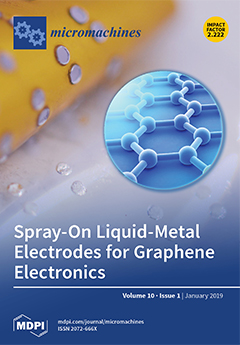Bi
4Ti
3O
12 square plates were synthesized via a hydrothermal route, and their growth process was systematically investigated. Carbon quantum dots (CQDs) were prepared using glucose as the carbon source, which were then assembled on the surface of Bi
4
[...] Read more.
Bi
4Ti
3O
12 square plates were synthesized via a hydrothermal route, and their growth process was systematically investigated. Carbon quantum dots (CQDs) were prepared using glucose as the carbon source, which were then assembled on the surface of Bi
4Ti
3O
12 square plates via a hydrothermal route with the aim of enhancing the photocatalytic performance. XRD (X-ray powder diffraction), SEM (scanning electron microscopy), TEM (transmission electron microscopy), UV-vis DRS (diffuse reflectance spectroscopy), XPS (X-ray photoelectron spectroscopy), FTIR (Fourier transform infrared spectroscopy), PL (photoluminescence) spectroscopy, EIS (electrochemical impedance spectroscopy) and photocurrent spectroscopy were used to systematically characterize the as-prepared samples. It is demonstrated that the decoration of CQDs on Bi
4Ti
3O
12 plates leads to an increased visible light absorption, slightly increased bandgap, increased photocurrent density, decreased charge-transfer resistance, and decreased PL intensity. Simulated sunlight and visible light were separately used as a light source to evaluate the photocatalytic activity of the samples toward the degradation of RhB in aqueous solution. Under both simulated sunlight and visible light irradiation, CQDs@Bi
4Ti
3O
12 composites with an appropriate amount of CQDs exhibit obviously enhanced photocatalytic performance. However, the decoration of excessive CQDs gives rise to a decrease in the photocatalytic activity. The enhanced photocatalytic activity of CQDs-modified Bi
4Ti
3O
12 can be attributed to the following reasons: (1) The electron transfer between Bi
4Ti
3O
12 and CQDs promotes an efficient separation of photogenerated electron/hole pairs in Bi
4Ti
3O
12; (2) the up-conversion photoluminescence emitted from CQDs could induce the generation of additional electron/hole pairs in Bi
4Ti
3O
12; and (3) the photoexcited electrons in CQDs could participate in the photocatalytic reactions.
Full article






